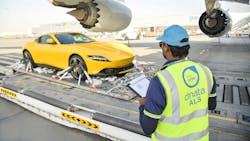How Connectivity and Technology Improve Cargo Logistics
The global year-on-year cargo volume is growing by around 5 percent in 2024 and the air freight business in the Middle East, through the opening months of 2024, has experienced a 45 percent year-on-year increase in cargo volumes through Dubai.
Given that trade lanes have shifted, volatility will increase and cargo handlers like dnata will need to be even more agile in this situation, affirms Guillaume Crozier, the company’s senior vice president UAE cargo and global cargo strategy.
“Some key milestones ahead include the enforcing of pre-loading advance cargo information, highlighting how big data is at the heart of our industry’s evolution. The demographic is evolving here in Dubai, which is another driver in terms of consumption goods,” he says.
“Towards the end of 2023, we also saw very solid volumes of e-commerce, both arriving at and transiting through Dubai, in time for the festive season,” Crozier continues. “We believe this will continue into 2024. There will still be very high-volume volatility in terms of seasonality, but also in terms of trade lanes as they are shifting. New countries are beginning to export higher volumes of goods than some existing nations.”
Network Connectivity
Network connectivity is paramount and is one of the key reasons why dnata Logistics is an active member of World Air Cargo Organization (WACO), an exclusive network consisting of several independent freight management companies across the world.
“As the world gets more interconnected and regulations get more stringent, freight forwarders must comply with an increasing number of requirements to clear formalities with authorities. They need to gear up their data management systems (e.g. HS codes, pre-loading information, e-commerce customs clearances), as such, software and data architecture capability becomes critical, affirms Crozier.
Connectivity is very important, and it is beneficial for everyone involved from the shipper to the forwarder to the end-consumer, declares Marcel Fujike, global head of air logistics IT and technology at Kuehne + Nagel.
“When we have greater end-to-end visibility, we can take more accurate decisions and our customers can plan their supply chains better, or it can also help us become more cost efficient and deliver higher quality solutions to our customers,” he says.
According to Stefan Pargfrieder, vice president for global air freight strategy and development at DB Schenker, network connectivity is the base for real-time data exchange, visibility, and prediction.
“Due to a lack of standard communication interfaces, freight forwarders often resort to device-based tracking services to be able to provide end-to-end (E2E) visibility. One example in real-time visibility is that the same shipment can be tracked by different systems and trackers used by the shipper, the forwarder, the airline, and the last-mile handler in the importing country,” he says.
“If we can combine the data from E2E and make it accessible for all parties, we can all lower our costs and increase our efficiency,” Pargfrieder adds. “An industry-wide (real-time) data exchange protocol could facilitate a move away from physical E2E devices to more data-based E2E visibility using various sources from telemetric data, data aggregators or small physical non-active devices, e.g. Bluetooth low energy (BLE) trackers.”
Network connectivity enables real-time information exchanges, allowing forwarders to connect to airlines, to their agents, and share real-time information with their clients, affirms Manel Galindo, chief revenue officer of WebCargo by Freightos.
“Connectivity all depends on speed: the faster different stakeholders can move information, the more efficient the market becomes, and the better service all parties receive – from the forwarder, to the forwarder’s clients, to the airlines. This being run as a vendor-neutral solution helps reduce the lift from individual forwarders or carriers while improving general industry digitization,” he says. “Technology also helps make information exchanges scalable. At WebCargo we do not rely solely on technology, we listen to our clients and pay attention to problems as they arise. We make sure that each part of the connection works and that information is flowing properly to our platform. This is crucial to bringing value to the freight forwarder.”
A 2024 target for dnata is to implement computer vision technology to help capture dimensions, weight of cargo and provide customers near real-time visibility of the process, a type of track and trace service, affirms Crozier.
“Furthermore, the new generation of dnata’s airport community system, Calogi, is launching in 2024 and will help to bring the customer more near real time visibility,” he says. “It will also provide the customer with more service offerings within the world of cargo and logistics. From a traditional warehouse offering to more third-party logistics and covering fulfilment centres, which is requested by our customers. This includes transportation on the ground, road feeder services and of course first-mile, last-mile activity for e-commerce.”
Main Challenges
In a widely fragmented industry, with the top 10 forwarders making up only around 35 percent of the total air freight market share, there is no overarching technology or data exchange standard, points out Pargfrieder.
“This challenge is further exacerbated in many cases by a legacy infrastructure. A mix of cheap real-time tracking technology and API aggregators will not be able to eliminate the current challenges; however, they will help to significantly reduce them,” he affirms.
The Role of Technology
Predicting demand and providing the right pricing is something that continues to be a challenge and an opportunity within air logistics, points out Fujike.
“As a logistics provider, we are lucky to have large amounts of data and a global network that helps us make accurate predictions based on that data,” he says.
According to Galindo, it is necessary to work on standardization.
“To overcome challenges, one must improve the market by standardizing for commodities. For example, if forwarders want to sell online, they need to make sure that everyone in the office gives quotes the same way, that the words ‘pick up’ and ‘customs’ mean the same thing across the industry,” he says. “Some people think ‘digitalization’ only means technology, but there is still a lot of work to be done internally to make sure that we use the technology effectively. It is a process that we went through with airlines, which is why e-booking has really taken off. Now we need to see this process happen in every part of freight forwarding logistics.”
In February 2024, dnata integrated autonomous drones into cargo operations in Dubai to enhance operational efficiencies and deliver benefits for airline customers, affirms Crozier. “Key results include a 20-percent reduction in processing times on rack inventories, and over 99 percent accuracy in shipment tracking. The drones have seamlessly integrated into the day-to-day workflow and warehouse inventory processes. On average, our drones monitor some 1,800 shipments daily with 99 percent accuracy across 2,400 rack locations,” he says.
As a last note, an ever-increasing cost base in aging societies will make it ever more difficult to attract talent to the freight forwarding industry, according to Pargfrieder.
“Technology can, in part, help to overcome the talent shortage and aging of the workforce and compensate certain previously manual tasks with automated technology,” he concludes.
About the Author

Mario Pierobon
Dr. Mario Pierobon provides solutions in the areas of documentation, training and consulting to organizations operating in safety-sensitive industries. He has conducted a doctoral research project investigating aircraft ground handling safety. He may be reached at [email protected].
